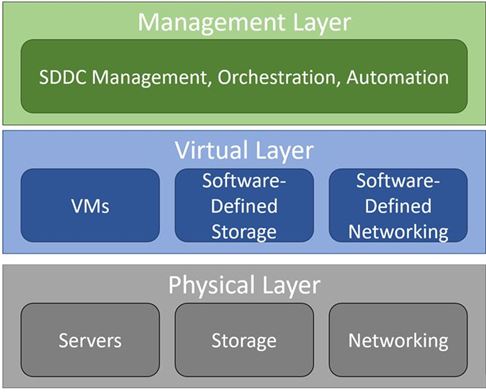Like a traditional data center, a software-defined data center (SDDC) houses servers, storage, networking devices and other IT or telecommunications hardware. However, in an SDDC all those infrastructure elements are virtualized and delivered as a service. In other words, the software is abstracted away from the hardware, which allows organizations to manage their compute, storage and networking resources as virtual pools. Instead of having to configure hardware manually, staff can control their infrastructure from one central software interface.
This type of architecture not only saves IT staff time, it also gives organizations more flexibility. In addition, it makes it easier to use inexpensive, commodity hardware rather than integrated solutions that can lead to vendor lock-in.
While the concept of virtualization has been around since the 1960s, the term “software defined data center” first came into common use in 2012. Steve Herrod, then the CTO at VMware began using the phrase to describe the evolution of the data center into an environment where everything was virtualized.
In the years after its introduction, the SDDC concept experienced a dramatic rise in popularity. By 2015, market research firm Gartner declared “the future of the data center is software-defined.” In the same press release, the firm predicted that by 2020 “the programmatic capabilities of an SDDC will be considered a requirement for 75 percent of Global 2000 enterprises that seek to implement a DevOps approach and a hybrid cloud model.”
There is no single piece of hardware or software that an organization can deploy in order to achieve a software-defined data center. Rather, SDDC architecture is a complex approach to data center management that requires the integration of many individual solutions.
While each software-defined data center will be slightly different, in general, SDDC architecture includes three basic layers: the physical layer, the virtual layer and the management layer. The physical layer is the actual hardware — the servers, storage and networking gear that takes up space in the data center.
The virtual layer is the software that abstracts each of these resources and delivers it as a service. It includes the hypervisor that manages the virtual machines (VMs) or, as is becoming more common, the container software. In addition, it includes the software-defined storage (SDS) and software-defined networking (SDN) software. It may also include other virtualized services, such as virtualized security.
On top of that is the management layer that ties everything together. This may include a software-defined data center solution, orchestration tools and/or automation capabilities that make it possible to run the data center from a centralized interface.

A software defined data center consists of three interlocking layers.
Managing a data center as an SDDC offers a number of benefits compared to traditional data center management:
Of course, migrating to an SDDC also carries risks and potential problems that must be overcome, including the following:
While it is possible to have an SDDC that isn’t part of a cloud, and vice versa, the two often go in hand. SDDC and cloud computing have a lot of overlap. Both deliver infrastructure as a service, and both rely on pooled and virtualized resources. In addition, sometimes the same management and orchestration tools can run both a cloud and an SDDC.
Organizations often deploy private cloud and SDDC technology at the same time because the two are so complementary. In other instances, organizations will first begin rolling out SDDC capabilities as a stepping stone to the private cloud, while firms that already have private clouds sometime embrace SDDC architecture as a way to improve manageability and further reduce costs.
In general, organizations that begin adopting SDDC architecture do not roll it out to their entire data centers at once. Instead, they usually deploy it in stages, often as part of their regular hardware refresh cycles.
As organizations experimenting with SDDC begin to see more benefits from the approach, analysts believe that it is likely that SDDC technologies will experience rapid growth. Trends like cloud computing and DevOps could also accelerate adoption. Allied Market Research says that the SDDC market is growing at an average 32 percent per year and predicts that the market will be worth $139 billion by 2022.
Two other technologies are likely to affect SDDCs: containers and artificial intelligence (AI). As Docker and other container technologies become more popular, it seems likely that future SDDCs will have more containers than VMs. And AI could augment the analytics and automation capabilities of SDDC management tools, further reducing the need for manual human intervention.
In short, the future of SDDC looks likely to hold even more growth and technological innovation that will enhance the benefits to organizations.
SEE ALL
Datamation is the leading industry resource for B2B data professionals and technology buyers. Datamation's focus is on providing insight into the latest trends and innovation in AI, data security, big data, and more, along with in-depth product recommendations and comparisons. More than 1.7M users gain insight and guidance from Datamation every year.
Advertise with TechnologyAdvice on Datamation and our other data and technology-focused platforms.
Advertise with Us
Property of TechnologyAdvice.
© 2025 TechnologyAdvice. All Rights Reserved
Advertiser Disclosure: Some of the products that appear on this
site are from companies from which TechnologyAdvice receives
compensation. This compensation may impact how and where products
appear on this site including, for example, the order in which
they appear. TechnologyAdvice does not include all companies
or all types of products available in the marketplace.